"Water, water, everywhere, And all the boards did shrink; Water, water, everywhere, Nor any drop to drink." - Rime of the Ancient Mariner, Samuel Taylor Coleridge
Holland is the land of the bicycle. I read it from home, read it again on the plane from Venice, but learned it first hand at David's Burgers in Leiden, Netherlands on Saturday night. As we waited for our burgers to get grilled up, I sat and watched the cyclists negotiate the T intersection; left to the train station, right to the University, and right then left over the bridge across one of the many canals that striped the city centre. I watched groups of young boys, young women in pairs and alone, old couples, families with two kids in the front. I even saw several riders hauling a friend sitting side saddle on the back rack. One girl straddled the front rack, facing the driver.
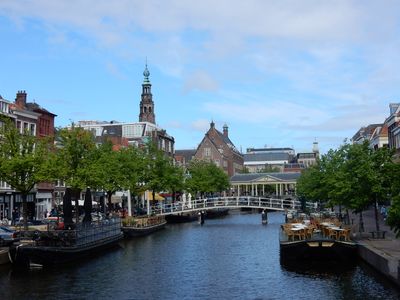
Leiden, Netherlands
My favourite was a young couple who were clearly on a date. Both were impeccably dressed, although the boy (who was driving) had a large pack on his back that his date needed to avoid, since she was sitting on the back rack, holding her purse on her lap and eating a banana with her free hand.
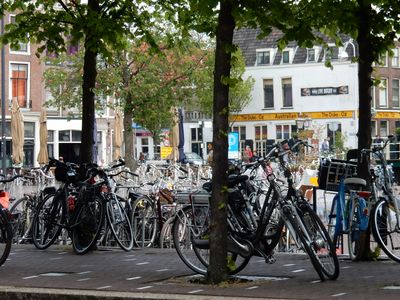
The bike parking is hilarious. There are way, way more bikes already parked than there are people in the town. There are racks everywhere. Many are double decker racks too. Rows and rows of them, throughout the town. And at any point in time they are 80% - 90% full, so people just park their bikes in the general vicinity of the racks. Most Dutch bikes have a quick and easy wheel lock that renders the bike useless when locked, so you don't have to actually lock the bike to anything.

So with all these bikes around us, picturesque towns all close together, and hundreds and hundreds of kilometres of smooth paved bike paths around us (over 7000km in the Netherlands as a whole), you'd think it would be easy to rent a bike, right? Not for us, anyway.
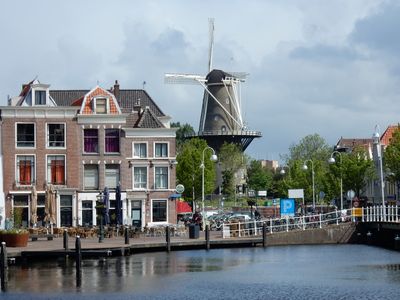
Leiden
We were looking for bikes and saddlebags to carry our clothes while we rode from town to town. But while bikes are available at every train station, they don't rent bags. And the places that might have bags to rent or buy were closed for their May long weekend. Argh.
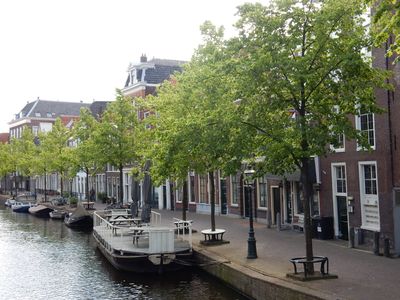
We did find one place in Leiden that could fit the bill. Budget Bikes (now there's a warning for you) was open on holiday Monday and had bikes and bags. At least I think they had bikes to rent. It said so on the window. But when we went inside the nice but shockingly dim young men had a really hard time coming up with two bikes to rent. They pulled one out of the back garage, and finally went through their stock of questionable used bikes for the second bikes. The bikes were old and clunky but the chains weren't too rusty so we gave them a go. But they were way too small, no matter how high we raised the seats. After a couple of hours of riding my knees and back were screaming at me as, hunched and dejected, I finally found the bike shop again and gave back the bikes. No way could we ride these for a week.
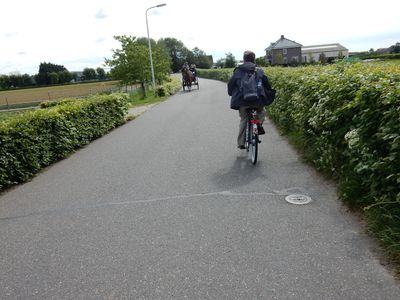
The knee breaker
So we explored Leiden on foot. It's an extremely picturesque little university town, 30km or so southwest of Amsterdam. Brown row houses lining cute little canals. Lots of good looking young people too.
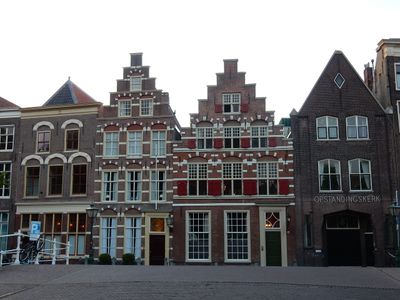
One of the shocking aspects of Holland is how expensive everything is, from food to clothes to accommodations. Especially accommodations. In Leiden, we stayed at a minor hotel so far out of town that it was right on the border of the next town and it was still our most expensive stay so far (it would seem cheap in a week.) It was a good long hike into the city centre, but there was an intercity bus that ran straight past the hotel, along the highway to The Hague, so we caught that if the weather threatened rain.
In all, we found that things in the Netherlands cost 1.5x to 2x what things cost in Italy, which was already 1.5x the prices in Portugal. Bus and train fare was double. Meals? Double. That 6 euro breakfast for two in Lisbon was 15 euros in Leiden. Lunch ran 20 - 30 euros. And supper? We tried to avoid restaurant suppers when we could, or did our 'two appetizers and a shared main' thing to manage our cash. We were here two weeks and had to make our funds last.
Accommodations were a challenge throughout. Not just the cost (which was routinely 50% - 100% more than anywhere else bar Paris), but availability. The Netherlands in general, and Holland in particular, is booked. The days of carefree Mediterranean travel, where we booked a room the night before arriving, and paid half or less than our benchmark (the Park Town Hotel in Saskatoon) were over. Now we paid like the Park Town and stayed in the Super 8. But there were a few lucky exceptions.
Back to these bikes. After the long weekend had passed, we took the bus to The Hague, figuring that the larger city would have a place that rented bikes and bags. But after a day of walking from bike shop to bike shop and finding only one shop that rented bags as well (a hippy run coffee shop whose owner insisted he had 'great bikes' in the basement), we decided to loop back to Amsterdam and go to the first bike shop I'd emailed from Italy. They had bikes, bags, and would store our suitcases while we toured. So the next morning we took the train to Amsterdam, got the bikes, and took them on the train back to Leiden. Then we rode the bikes back to The Hague, experiencing the Netherlands bike route junction network for the first time.
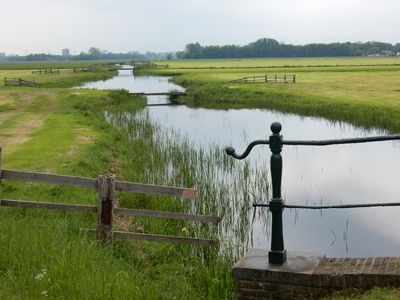
These are the coolest thing. As I mentioned, there are over 7000km of paved bike lanes all over the Netherlands. The larger paths are part of the junction network, a spider web of paths that connect every town and village in the country. Armed with a map of South Holland, we could trace a path anywhere we wanted to go.
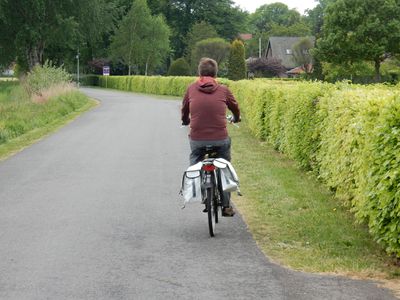
Here's how they work. Every major bike path intersection is given a number. There's a sign at the intersection with the number, plus arrows giving directions to the next junctions. For example, if I'm at junction 70, the sign will say go left to get to #68, right to #53, and keep going straight to #71. So all I have to do to get from Leiden to The Hague, for example, is write down all the junction numbers I need to pass through, in order, then connect the dots as I ride along.
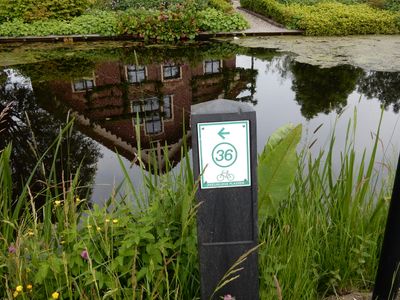
It's not perfect; some of the sign are vague, like when a single arrow points in between my two options at a fork in the road. Or when a low post is buried in extra long grass. Or when road construction, usually around a busy train station when we're leaving a city, forces a detour around your junction.

Blink and you miss it!
But we found an app for Cindy's phone which had the paths marked, if not the junction numbers. So when we left the path we could at least figure out which way to ride to get back on it.
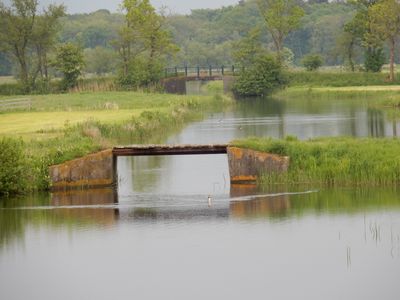
For our first ride, from Leiden back to our apartment in The Hague, we retraced the bus route we took the day before for a while, before heading west to the coast. The Hague is very close to the Atlantic Ocean, so we cycled past gorgeous farms, then private villas and mansions, before hitting sand dunes and the coast. Rain was coming quick so we didn't linger, and we certainly didn't swim, but it was great to see the ocean, the long sandy beach, and the huge barges off on the horizon.
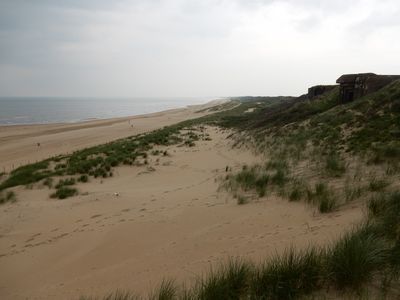
The Hague is a beautiful city, one of our favourites on the whole trip. It's the seat of government in the Netherlands, (although Amsterdam is the capital; quite different from home) so you've got fine government buildings and lots of attractive, prosperous people on the streets. And there's also a lot of very stunning, unique modern architecture, from the massive, all white City Hall and public library to the funky, new De Resident neighbourhood right beside the historic main square. De Resident is extra cool; they got a different architect to design each apartment building, so each building is unique. But each building also ties into it's surroundings as well. They act as a bridge between the old city to the west and the modern skyscrapers to the east.
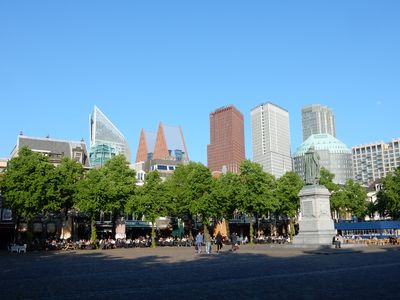
We were extremely lucky to find a cheap studio apartment right in the De Resident neighbourhood. We had a great modern flat, with these stunning buildings on one side and the old town on the other.
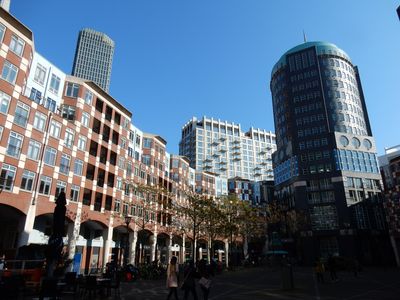
We would've easily stayed two more days there but, alas, it was booked. So we spent another half day walking about after our ride from Leiden and headed out the next day.
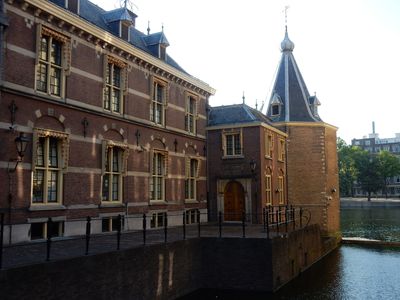
From The Hague, we rode south and east to Delft. It was a great ride, but cold. Although the clouds threatened all day, we stayed dry for the most part, riding on smooth, straight roads, along beautiful canals and past tidy little farms. Of course, we realized too late we were on the wrong side of one particularly long canal, so rode a few kilometres extra before finding a bridge and doubling back to our hotel. It was a modern place, The Shanghai Hotel Holland no less, but it was an easy ride to Delft town centre once we dropped off our saddlebags.
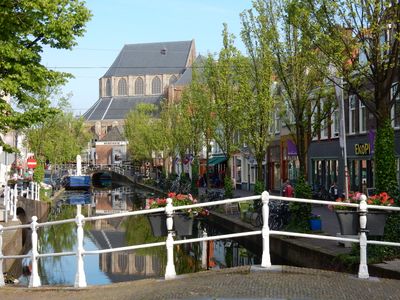
Delft
Delft is small and charming. It's known for its blue glazed pottery, which guarantees some tourists, but it's also a university town, so there's lots of energy to the place. We spent a delightful afternoon and morning wandering up and down the streets, crossing every bridge and sitting down at as many cafes as we could handle. We found a great mom & pop bakery for coffee and pastries, and also found the square where all the students went for evening coffee. Great fun.
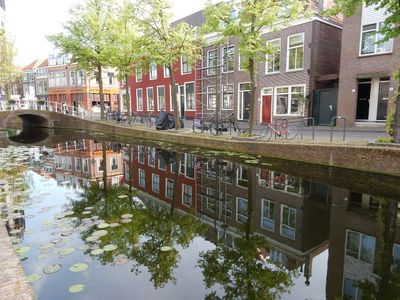
Just as we were about to leave Delft, we stumbled across one of the best experiences of the trip. We were crossing the main square, between the large church at one end and the hall at the other, when a newly married couple left the church and cycled over to the hall, followed by the wedding party and all the guests. All were dressed up, carrying blue and white balloons, and all were riding bikes. The lovely bride was in a cart in front of the lead bike, pedalled by the groom. In the background, the church carillon played wedding melodies while the bride and groom did two loops of the square then led the entire procession into the hall. It was elegant, teary-eye romantic and very, very Dutch.
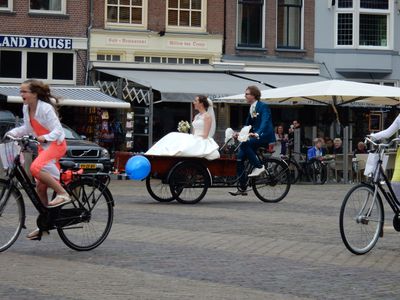
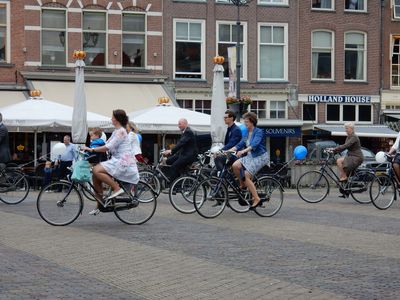
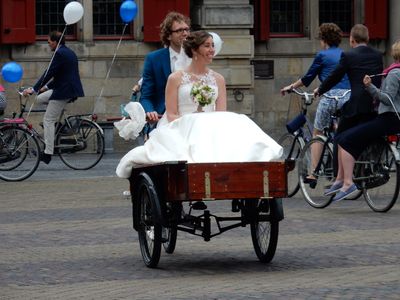
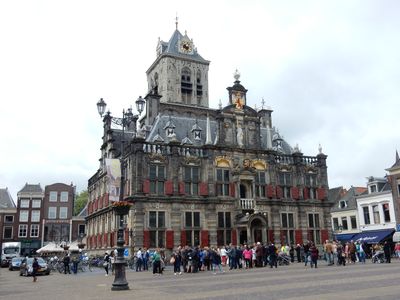
From Delft we rode on to Rotterdam, one of the largest modern port cities in the world. But you wouldn't know it from the ride; we spent a cloudy and rainy morning cycling through polders, the low fields that are completely surrounded by canals and are actually lower than the larger canals that run along side. Most of the polders had two or three cows, or some sheep and lambs, or maybe a few goats, all lazily grazing on the lush green grass.
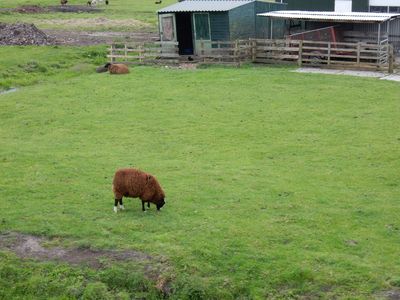
The canals were a blast. I've never seen so much wildlife so close before. We cycled past families of ducks who had nests in the middle of the water, or wedged into the bank. We saw huge white swans, many geese and even several great blue herons, just doing their thing in the water. They weren't scared of us at all. Heck, I got scared when we'd ride past some tall grass and an unseen duck quacked right by my foot!
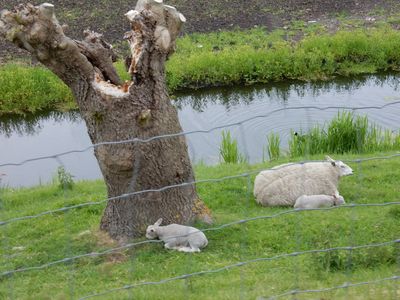
Rotterdam is another of our very favourite cities. The combination of waterfront and crazy modern architecture is exceptional. It reminds me of a quiet version of Vancouver.

Out hotel in Rotterdam was right downtown, on the canal, on a converted barge no less. We were right near all the action and breakfast was included. Excellent! We locked up the bikes and spent the next few days wandering around this beautiful city.
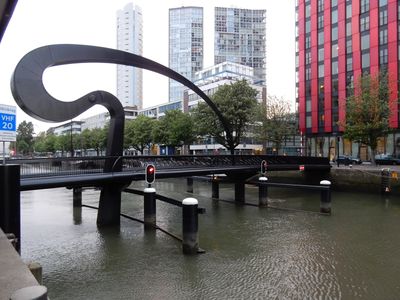
Even the drawbridges are funky!
Our first stop was just up the road at the Markthal, Dutch for Market Hall. Holy Cow, what a place! Cindy read that at one point the Dutch were concerned that the European Union would outlaw open air markets (as if!) so in typical Dutch fashion they fixed things by building a massive, 10 story tall dome and put the market inside. The ends of the dome are just clear glass, but the sides are 10 floors of apartments and restaurants, that curve around the dome. I still can't get over this structure; I can't even decide if it looks better from the outside or the inside! But the food inside is amazing and the restaurants are very good too. There's even a Jamie Oliver Italian restaurant there that seems very popular.
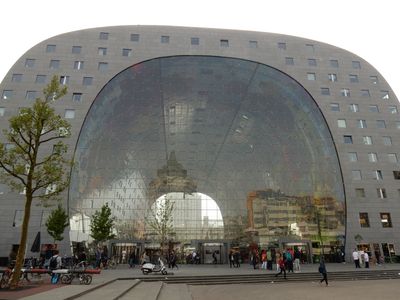
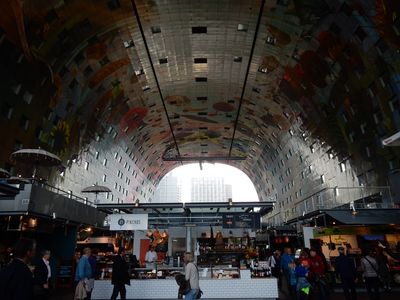
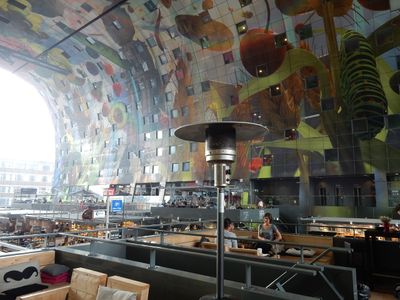
While the Markthal has permanent stalls inside, there's still a massive twice weekly outdoor market on the square beside. So as it was now Saturday we checked that out too. Lots of fruit, meat, fish and cheese, along with all the household items and clothes that fill out these markets. I chickened out though and passed by the haring (herring) stand, although I watched a few locals eat the cured fish, smothered in raw onions, in two big bites.
Across the square from the Markthal is the Rotterdam Public Library, one of the best libraries I've ever been in. Even better than Bologna. Not only are there a ton of books and other media, but there's a pretty good coffee shop too. It's full of cookbooks so you can read while enjoying a drink.
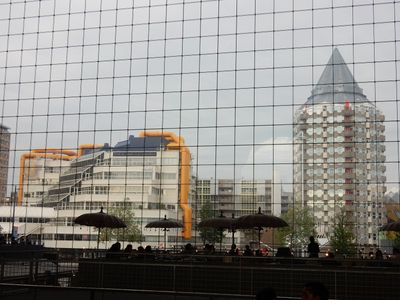
The yellow building is the library!
You may know that I'm a big fan of libraries. 10+ years after stopping the planned shrinkage of the Regina library system, I'm worried we've stagnated a bit at home. I was encouraged by some of the cool modern libraries I saw in European cities big and small, but especially in Rotterdam. It's in a great location, is in an amazing building, and has a ton of places to sit and work. And you know what? It's busy! We could barely find a seat to read and write in the six floors we checked out. I guess if you make a comfortable space to read and work, people will use it. Time to get busy at home...
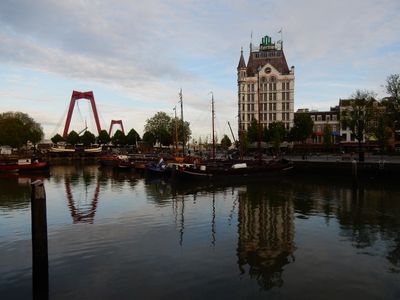
For one day on our stay in Rotterdam, we left the city via the water-bus and travelled just outside of town to Kinderdijk. It was time to figure out windmills.
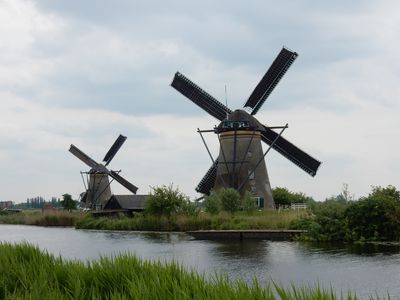
Much of the modern architecture in Rotterdam is because they had to rebuild the city after bombing in World War 2. But the bombs missed Kinderdijk and there are still rows of windmills dating from the 1740's there. We walked along the polders and went inside two windmills to learn more about how they worked and what it was like to live in one.
The windmill operator lived in the mill permanently, with his family. In one windmill, the operator lived with his wife and thirteen children! It was a tough life and things changed only recently. Windmill operators lived in the windmills up to the 1950's.
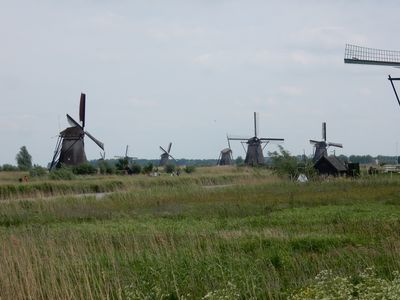
Now here's how they work. Remember how I mentioned that the polders are lower than the surrounding land? Well, the windmills help keep the polders from filling back up with water. A row of windmills sits on a narrow strip of land between the polder canals and a higher canal. When the wind blows, the windmill turns a big wheel that literally scoops the water from the lower polder canal and throws it up into the higher canal. Then, another set of windmills throw the water from the higher canal up even higher, into the Lek River.
That's right, all the land is lower than the level of the river! It's fascinating engineering, but it really brings home how the Dutch have literally built their country. Most of Holland would be a large inland sea if it weren't for all this moving water.
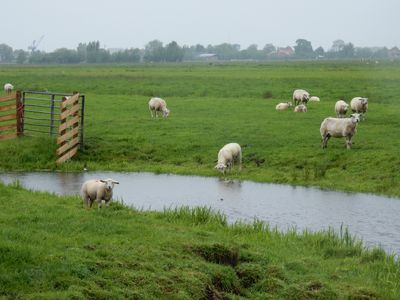
Monday morning was rainy, but we had booked rooms up the road, so we bundled up and set out for our next destination, Gouda. Land of cheese, but with many more names than just 'Gouda.' The ride was hard; even though there's a finite amount of 'wet' one can get, it's pretty cold riding. But after around an hour and a half of riding, the rain stopped and we slowly dried out.
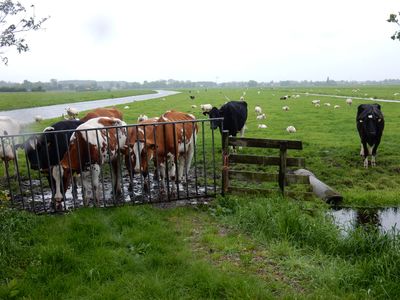
The highlight of the day's ride was just outside of Gouda, when we rode past a community garden. But this was much more than a collection of garden plots. Each plot had a large shed/small cottage that was clearly made for the gardener. A place to hang out as he tended his crops. Many of the plots looked more like small yards than a mere vegetable patch. We wandered around and checked things out and took pictures of the sheds. Hopefully I can build one at home and turn it into a writing studio. With a day bed.
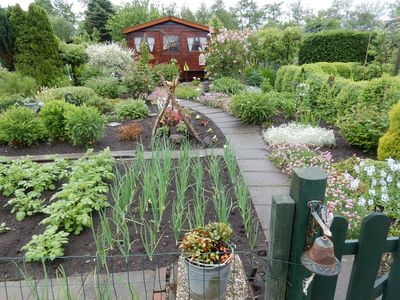
Gouda was yet another picture perfect little town with a shop lined centre, lots of canals and in this case, a very ornate old town hall right in the middle of the square. While it looked pretty large to me, the hall is too small for a town as important as Gouda, I guess, so they built a new town hall just outside the centre. Surprisingly, it's designed to remind one of a stroopwaffel. Not cheese. That's because the cinema, right next door, already looks like cheese.
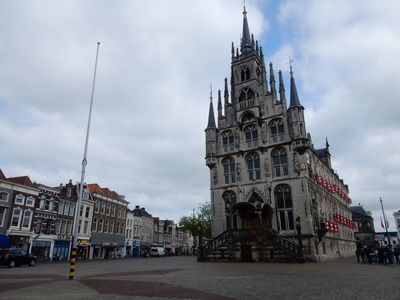
The old town hall
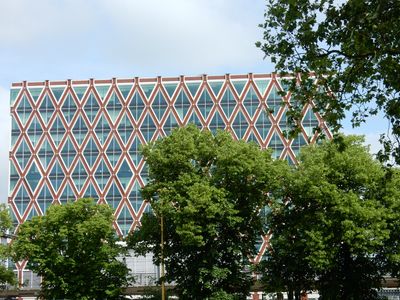
And the new one
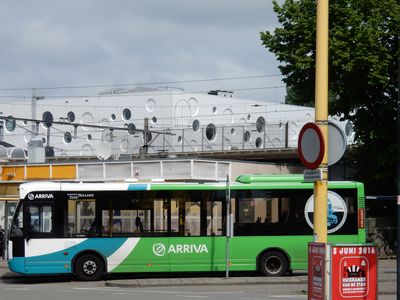
The cinema in the background
For all the cheesy time we had, we did actually find a very, very good cheese shop in Gouda. We got some lessons on how to pick a good cheese, ate far too many samples, then picked up a few wedges for our packs.
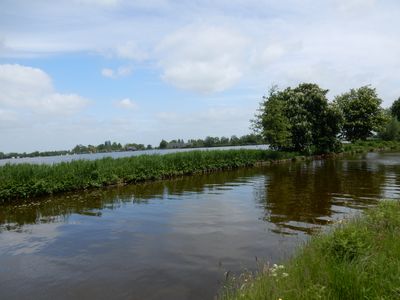
From Gouda, we headed north and west to another University town, Utrecht. It was a fun ride - no rain - but the clouds were threatening all day and we were buffeted by a strong crosswind. The land wasn't a lowland polder fest, instead it was much more park-like, and it was as green and as full of wildlife as ever.
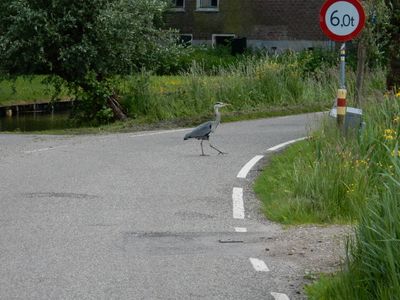
We just kept tracking our junction points, stopping for a snack now and then, and in a few hours we were at our new apartment. But not until we negotiated some major construction work, right around the train station, of course, and at rush hour. In Holland, rush hour means a lot of cars but even more bikes, so it was a very, very crowded bike lane for a while.
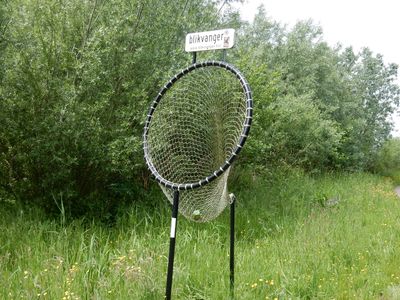
high speed trash net!
Utrecht was a really fun town. We rented a traditional Dutch home, a very comfortable, narrow row house with steep, twisty stairs and a small back garden. It belongs to Solveig, a very nice young woman who is studying at the University. We had a great visit when we arrived and learned a bit about the Dutch post-secondary school system. There are three types of Universities depending on the type of courses, which explains how everywhere we went was a 'University Town.'
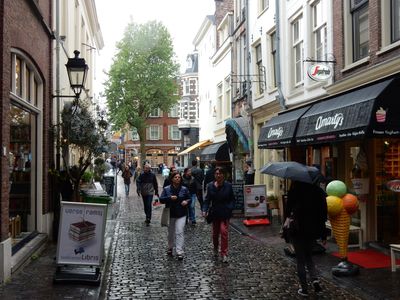
The architectural highlight about Utrecht, aside from the excellent library (why are all Dutch libraries so awesome?) is the Dom Tower. It's the highest bell tower in the Netherlands, even though it's no longer attached to a church! It used to be connected to a very large cathedral, but a large storm in the 1600's destroyed half the church, right in the middle. The Protestants, who ran the church at the time, figured it was a Sign that the church was too gaudy, so left the centre in ruins. Now the centre has been cleaned up and is the delightful Dom Square, an open square between the tower and the remaining church.
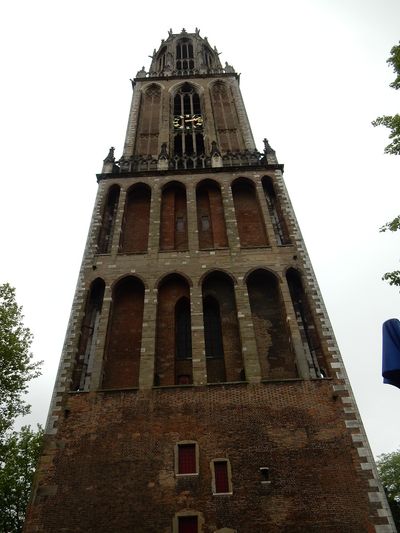
They give guided tours of Dom Tower and we took one. It's very good. The tower is so big that we stopped on three levels to learn about what was going on. Not just up then down like in Siena. The first two levels are private chapels, and the top two levels contain all the bells. Both 14 large bells, of which seven still remain from 1502, and a 40+ bell carillon that can played like a very large organ. The carillon can be played by a musician, but is also connected to a large wheel that plays a melody every 15 minutes. The melodies can be programmed much like a paper reel on a player piano, but with large metal pins and the tune changes over the year. We were told that the new carillon player in town is young and modern and will even play rock tunes on the bells when she has a concert!
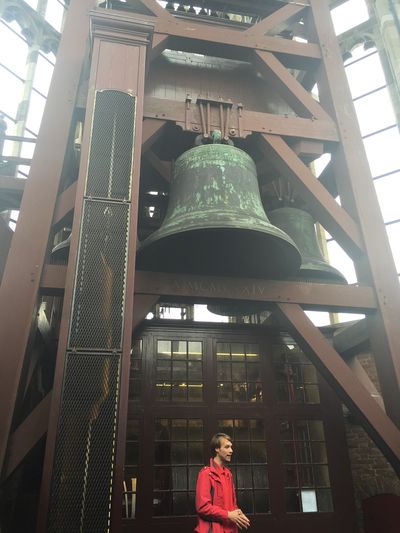
The purpose of this leg of the trip was cycling, so we didn't linger for too long in any one city. But we did get a full day and night in Utrecht, which meant we walked back to the centre that night for a 'Utrecht by night' walking tour. Students have set up light displays throughout the centre that run after sunset (around 9:45pm in May) and there's a walking route to see them all. Some lights are on buildings, some in the trees and others are under bridges along the canals.
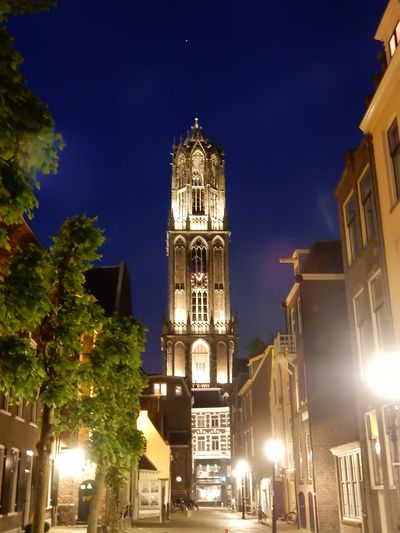
While the light displays aren't too spectacular, the walking loop is a lot of fun. Tiny illuminated arrows are placed in the cobblestone sidewalks every so often, marking the route. They are far enough apart that you really have to look for them, and on quiet, nearly deserted streets in a Medieval town centre, it can get a little spooky. And there was a big payoff at the final point of the tour: the Dom Tower was lit spectacularly, right at the very top of the 95 metre tower. Right at the top of the hour, the lights went out, then the carillon played for a long time as the lights came back on and swirled and danced over the face of the tower.
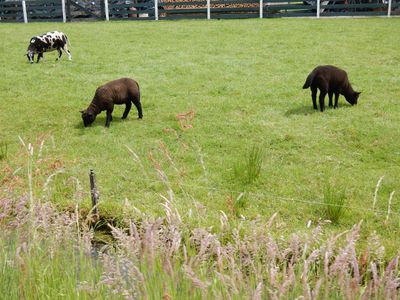
For our final ride of our Holland loop, from Utrecht back to the bike shop in Amsterdam, we finally got some sunshine. Eight days of cloud and intermittent showers, plus one day of just plain rain, was making the bike rides a bit of work. But this day the sun was out and the sky was blue (well, blue-ish) as we set off on the bike path. Our route took us away from the highway and even away from farms; today we were in cottage country. We rode along large lakes filled with small yachts and lined by very fine cottages. Some were all out villas. Ahoy, rich folks!
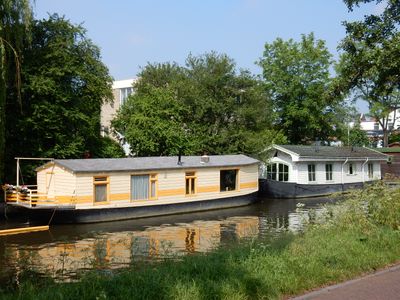
It was our best ride of the trip, even though it was the longest. Only 30km by car, the windy bike path is much longer, but much more beautiful, so it took us five hours to get to Amsterdam. But it was lovely.
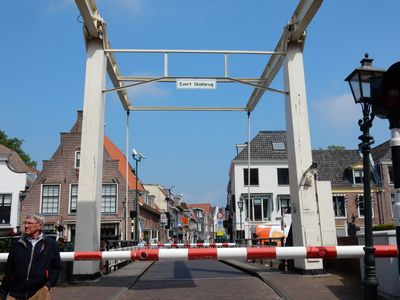
Some of the canals seemed completely dedicated to cyclists. At one point, there was a manual 'bikes only' ferry to get us across the canal! We loaded our bikes on, then turned a crank again and again to pull the ferry across the canal. What fun! At another crossing we once again needed a ferry, but we were now crossing the Amstel river so there was a proper boat and driver.
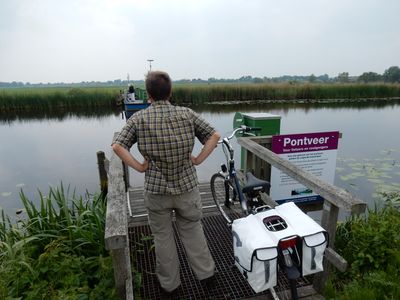
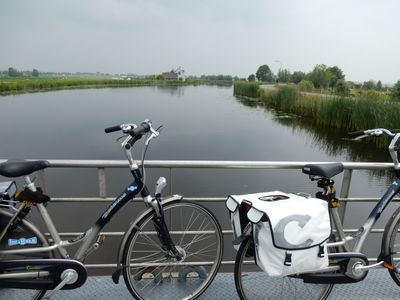
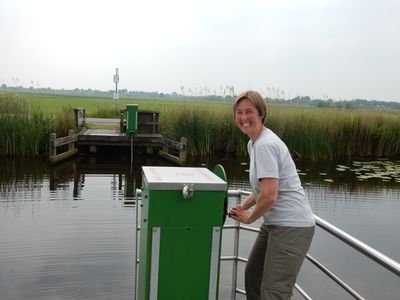
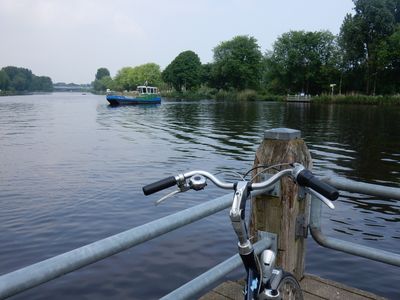
And then, there we were. Amsterdam. One second we were riding down a country lane, then we crossed a bridge, turned a corner and saw a stack of glass skyscrapers. We made it. By this point we blended in fairly well with the locals, screaming down our bike lane, turning corners without flinching, and cursing out tourists who kept walking in 'our' lane.
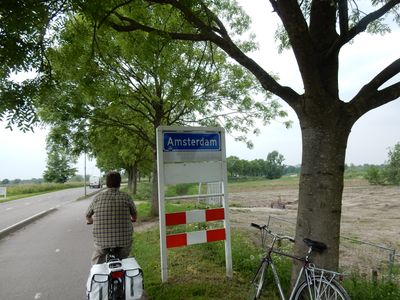
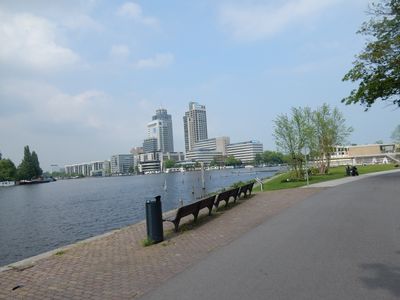
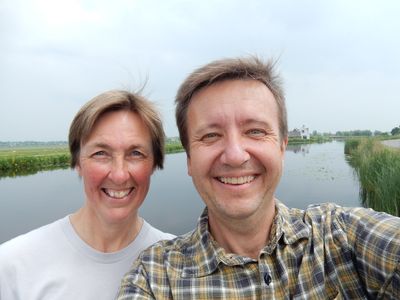
The final three blocks to the bike shop, deep in the heart of Damstraat and tourist central, was a little hairy, but we made it, returned the bikes, reclaimed our suitcases, blended in with the hoards and found a tram to our final AirBnb.
Amsterdam has a tourist problem, and they know it. The 'Old Town' area between the Central train station and Damstraat is completely, utterly clogged with tourists and weed smoking hippies. It's not a lot of fun down there; maybe 25 years ago, but not today.
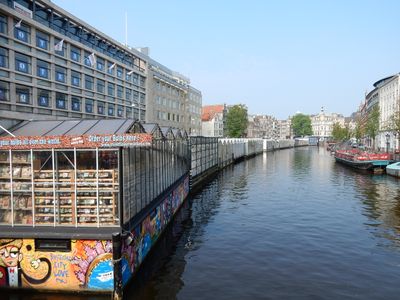
They had a great display at the library (another winner - what is it with Dutch libraries?!) about the tourist problem in the Old Town. They see how tourism is only growing and they have to choose between being like Venice (the city as museum and nobody can live there anymore) or New York (lots of tourists but people live and work in Manhattan too.) And they have the building plans to change things too. It was cool to see such forward thinking about their city.
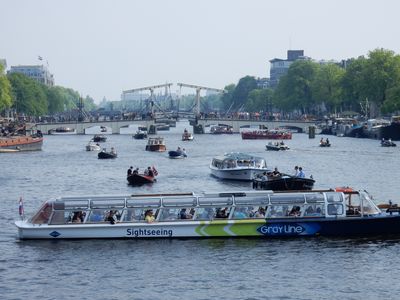
But as crowded as it is, get outside this 5-10 block area and the city opens up amazingly. Literally, just go from this block where you can't even see the buildings for people, walk across the bridge and go one block and it's peace, quiet and locals. So that's what we did. Even when we had to go 'across town', we steered around the centre instead of going through, and had a delightful three days in Amsterdam.
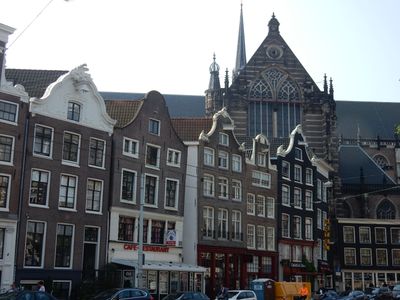
It still took a while to warm up to Amsterdam though. Too many thoughts about heading home, too many realizations that this would be my last good coffee, or Cindy's last poffertje (tiny pancake treat) to enjoy what was in front of us. Plus I got a nasty flu bug on our first day and was too dizzy to ride the tram into the city; it took a day to get fit enough to walk around. But finally, on Sunday, our last full day in Europe, we figured Amsterdam out.
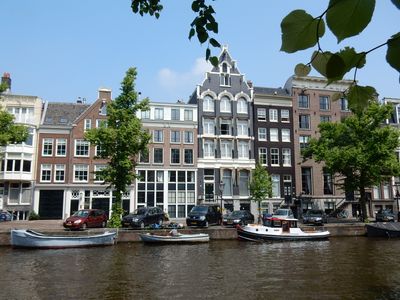
It started in Vondelpark, a large, pedestrian/cyclist only park in the middle of the city. Seeing so many people out enjoying the day shook the gloom off my shoulders.
Then the good vibes continued as we walked along lovely tree-lined streets, with a canal in the middle and tight, narrow, crooked row houses running the length of the block. We stopped in bakeries, took a good look at what everyone was eating for brunch, and window shopped for shoes and a new suit.
Finally, we turned the corner and fell in love. We had reached the Museum Quarter, with a gorgeous concert hall at one end, the massive Riksmuseum at the other, and the ultra-modern Van Gogh Museum in the middle. Beside the Van Gogh museum was a huge green space, and behind that, an exceptionally cool open air antique market. And within the market, was the coolest trio of street food vendors ever.
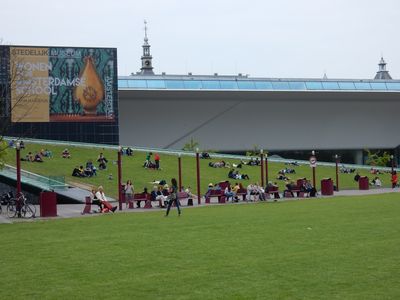
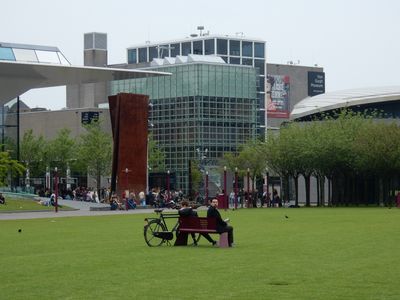
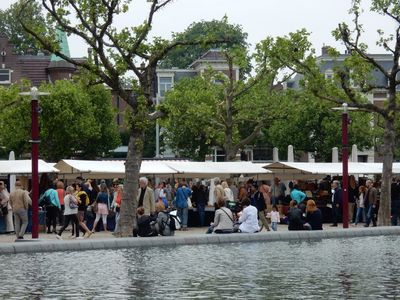
Poffertjes, made fresh and served hot. No syrup, just butter and powdered sugar.
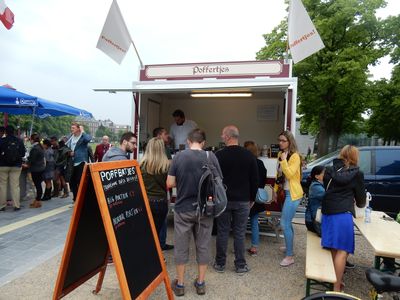
French Fries, fried twice and served in a cone as the Good Lord intended.
And finally, a French stall serving grilled sausage, on a slice of toasted rye bread, with one swish of mustard. Simple and perfect.
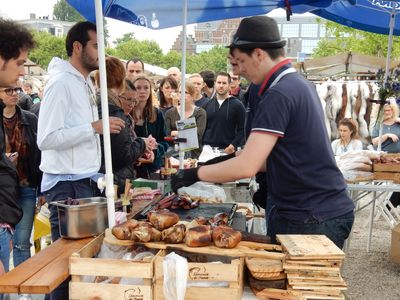
Oh yeah, served with a glass of wine too, because we're in Europe and it's a civilized place. Not only will the world not end if you have a glass of wine in the park on a Sunday afternoon, but maybe your Sunday afternoon will be just a little better. A little more awesome. A little more perfect.
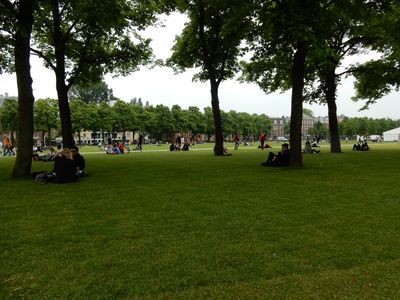
It was for us. So perfect that we enjoyed every bite, savoured every sip, and felt a connection with every soul who was sitting in the park with us on a cool, grey, gorgeous day in Amsterdam.
Then we cried a few happy tears, went back to our apartment and started packing. Tomorrow we go home.